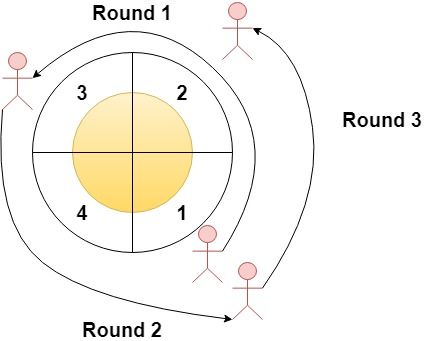Given an integer n and an integer array rounds. We have a circular track which consists of n sectors labeled from 1 to n. A marathon will be held on this track, the marathon consists of m rounds. The ith round starts at sector rounds[i - 1] and ends at sector rounds[i]. For example, round 1 starts at sector rounds[0] and ends at sector rounds[1]
Return an array of the most visited sectors sorted in ascending order.
Notice that you circulate the track in ascending order of sector numbers in the counter-clockwise direction (See the first example).
Example 1:
Input: n = 4, rounds = [1,3,1,2] Output: [1,2] Explanation: The marathon starts at sector 1. The order of the visited sectors is as follows: 1 --> 2 --> 3 (end of round 1) --> 4 --> 1 (end of round 2) --> 2 (end of round 3 and the marathon) We can see that both sectors 1 and 2 are visited twice and they are the most visited sectors. Sectors 3 and 4 are visited only once.
Example 2:
Input: n = 2, rounds = [2,1,2,1,2,1,2,1,2] Output: [2]
Example 3:
Input: n = 7, rounds = [1,3,5,7] Output: [1,2,3,4,5,6,7]
Constraints:
2 <= n <= 1001 <= m <= 100rounds.length == m + 11 <= rounds[i] <= nrounds[i] != rounds[i + 1]for0 <= i < m
class Solution:
def mostVisited(self, n: int, rounds: List[int]) -> List[int]:
if rounds[0] <= rounds[-1]:
return list(range(rounds[0], rounds[-1] + 1))
return list(range(1, rounds[-1] + 1)) + list(range(rounds[0], n + 1))class Solution {
public List<Integer> mostVisited(int n, int[] rounds) {
int m = rounds.length - 1;
List<Integer> ans = new ArrayList<>();
if (rounds[0] <= rounds[m]) {
for (int i = rounds[0]; i <= rounds[m]; ++i) {
ans.add(i);
}
} else {
for (int i = 1; i <= rounds[m]; ++i) {
ans.add(i);
}
for (int i = rounds[0]; i <= n; ++i) {
ans.add(i);
}
}
return ans;
}
}class Solution {
public:
vector<int> mostVisited(int n, vector<int>& rounds) {
int m = rounds.size() - 1;
vector<int> ans;
if (rounds[0] <= rounds[m]) {
for (int i = rounds[0]; i <= rounds[m]; ++i) ans.push_back(i);
} else {
for (int i = 1; i <= rounds[m]; ++i) ans.push_back(i);
for (int i = rounds[0]; i <= n; ++i) ans.push_back(i);
}
return ans;
}
};func mostVisited(n int, rounds []int) []int {
m := len(rounds) - 1
var ans []int
if rounds[0] <= rounds[m] {
for i := rounds[0]; i <= rounds[m]; i++ {
ans = append(ans, i)
}
} else {
for i := 1; i <= rounds[m]; i++ {
ans = append(ans, i)
}
for i := rounds[0]; i <= n; i++ {
ans = append(ans, i)
}
}
return ans
}
